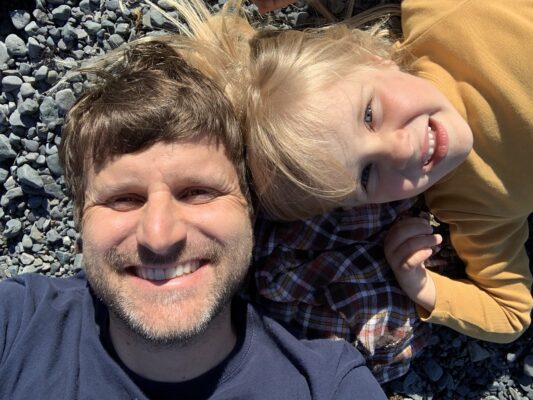Lean in closer. Let me tell you a story about whitewater. A story not just about boiling holes, surging eddies, beat downs and swims (though there is some of that). It’s a story about life. Death. Risk. Coming of age. A midlife crisis. It’s a story about a person fumbling to remember what’s truly important. It’s a story about me. But it could probably just as well be about you, for we all have our obstacles, our fears, and our triumphs.
To understand this story completely, let’s backpaddle. Upstream and back in time until we find a naïve eleven-year-old paddling a tandem canoe, poorly, with his mother on a bump-and-grind stretch of Arizona’s Verde River. Though we may have dumped that 15-foot Mad River more than once that day, the seeds were planted for a hobby that grew into a lifelong passion.
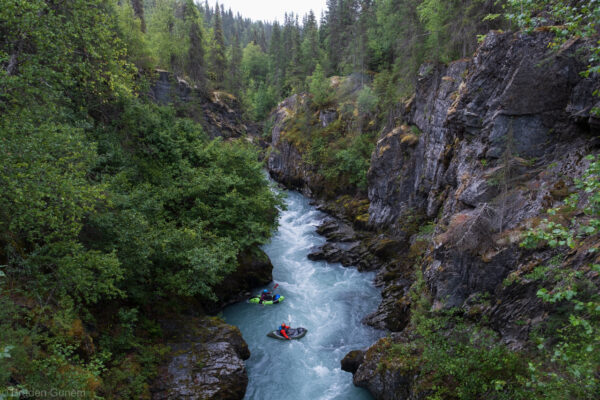 In the months that followed that first-ever river trip, I threw myself into the sport of whitewater paddling. I bought an inflatable kayak and ticked off some classic Southwest rivers: the Dolores above Bedrock, the Green through the Gates of Ladore. By the time the leaves withered on their branches that fall, I was a river addict.
In the months that followed that first-ever river trip, I threw myself into the sport of whitewater paddling. I bought an inflatable kayak and ticked off some classic Southwest rivers: the Dolores above Bedrock, the Green through the Gates of Ladore. By the time the leaves withered on their branches that fall, I was a river addict.
As a kid, I had a knack for plunging neck deep into my interests. Sports, dinosaurs, extreme weather: when a topic grabbed my curiosity I pursued it with reckless intensity as if nothing else in the world mattered. With this eagle-eyed focus, I passed my middle school years memorizing river guidebooks when I should have been studying pre-algebra and world history. By the time I was 13, I could quote the lengths, major rapids, and boating history of every significant river in the American West. My heroes swapped from Michael Jordan and John Elway to Walt Blackadar and Eric Jackson. And any chance we had, my father and I loaded up his Chevy Blazer and blasted across Arizona chasing every fleeting stretch of floatable river that dry state allowed.
I loved everything about whitewater: dissecting a rapid while scouting from shore, feeling the rush of adrenaline at an approaching horizon line, executing the envisioned line with surgical precision, and basking in elation in the eddy at the bottom. But paddling was always more than just rapids and risk. I loved the smell of the river, the wildlife that gathered along its edges, the side hikes that revealed enigmatic wonders, and the camaraderie of huddling around a campfire with friends while swapping whitewater tall tales.
For the next 12 years my love of the river bloomed. I bought my first hardshell kayak. I became a certified instructor and attempted to inspire my same passion in others just arriving at the sport. At the relatively tender age of 21, I became part owner of a paddle shop in Glenwood Springs, Colorado, a hamlet of 10,000 nestled on the alluvial delta where the Roaring Fork and Colorado Rivers collide. I competed in FibArk, even made finals once in the expert division. I joined a town committee that built the first ever whitewater park on the Colorado River. And at every opportunity, I threw myself down any harrowing chute, roaring plunge or tree-lined gorge I could find. Whitewater and rivers were the love of my young life.
In 2007, however, everything changed. The Great Recession seized the country. Crippled by a difficult market and my own mismanagement, my kayak shop floundered then failed. Broken-hearted and stripped of my life’s savings, my love of the river withered and began to dry up. I shifted to other pursuits: rock climbing, mountaineering, hiking, playing guitar. My paddling skills atrophied; my paddle hung forgotten in a dark garage.
It wasn’t until ten years later and 2,500 miles away, that I met the other character in this story, the one that would re-kindle my love for whitewater in a way that my now almost-middle-aged body had almost forgotten.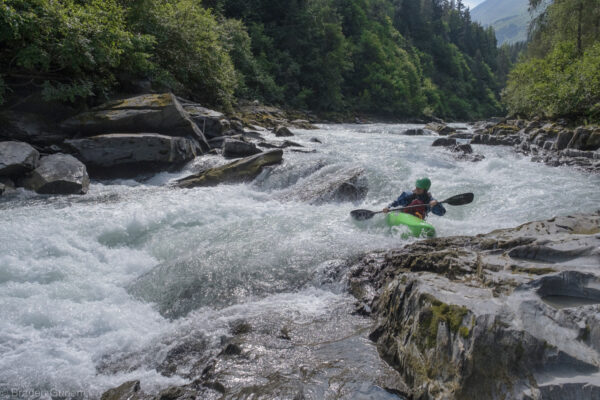
This character was a river.
Not just any river, but a rowdy gem that carves through a lush Alaskan gorge of towering conifers and flood-smoothed granite. Its clear-blue waters dump over dark ledges and whirl around gumdrop boulders draped with emerald moss. Occasionally, carmine-hued sockeye leap and flop up its steep plunges to spawn, then die.
This river is called Sixmile.
Located in Southcentral Alaska, Sixmile Creek was “discovered” by western culture in 1895 by goldpanners hoping to lift their fortunes from its waters. These hardy pioneers erected rustic cabins along Sixmile and spent long, lonesome days sieving through the silt and gravel of its riverbed in search of “the Color.” To date it is estimated that 2,000 troy ounces of gold have been found in Sixmile, a score worth about $3.5 million at today’s rate. It wasn’t until much later, however, that a different brand of adventurer discovered the creek’s whirling water: river runners.
In the early days, Sixmile was considered cutting edge, dared only by teams of experts during ideal conditions. Though today much more difficult whitewater is routinely explored all across the Last Frontier, Sixmile maintains its reputation of respect and awe. And if the number of fatalities and near misses that still trouble this relatively small river is any metric, Sixmile’s fearsome reputation is well earned.
Akin to more famous classics like Gore Canyon, the Upper Gauley, and the Chattooga, Sixmile is the region’s premier test piece: an entrance exam one must pass before toeing into Alaska’s more harrowing stretches. Like those other benchmark rivers, Sixmile clocks in at high class IV to low class V, has reliable water, is conveniently located with easy access (especially by Alaska standards), and is even home to a whitewater festival.
Though I knew of Sixmile by reputation for many years, my inauspicious introduction came in the summer of 2017 during the Sixmile Creek Whitewater and Bluegrass festival, a quirky, Alaskan-style (low on organization, high on character) event. In front of my eyes, a non-racing attendee attempted the class IV First Canyon in a lake kayak with fishing waders, swam in the first rapid and became pinned on a submerged log. For nearly five minutes the swimmer was trapped, water fanning over his head. Were it not for the brave, and perhaps foolhardy, decision of another boater to jump in upstream and grab him, he would almost assuredly have died.
Shaken by the experience, I walked away proclaiming that I would never paddle Sixmile: I was too rusty and too much of a chicken to build back up to this test.
Three years later, however, I was bobbing in a kayak at the top of one of Sixmile’s signature rapids, Merry Go Round, wondering what the heck I was doing. Beside me floated Braden, another approaching-middle-age kayaker also attempting some sort of whitewater comeback. We sat on river right, trying to pick some sense from the chaos of exploding waves and hydraulics below.
It was the Fourth of July and the sun was blistering hot. Clouds from a previous storm had peeled apart to reveal flawless blue horizon to horizon. Sixmile was rolling along at 1,450 cfs, which translated to 10.0’ on the river’s only gauge. It was a strong medium level, and the highest I’d seen it.
The previous summer I’d found my way back to whitewater through the sport of packrafting. Though I’d once written off those tiny rubber craft as a novelty not worthy of whitewater respect, in Alaska—a place where the rivers are many but roads are few—packrafts are a craft that just makes sense. Starting on lakes and slowly graduating to easy rivers, I remembered how much I loved being on the water and couldn’t seem to remember why I’d quit. As my skills slowly returned, I began daring more and more challenging rivers. My mind turned back to Sixmile. Did I still have what it took to paddle such a fearsome river?
I was about to find out.
“Should we scout this one?” I asked, trying not to sound nervous. Braden, perhaps brazen after flawlessly navigating all of what Sixmile had thrown at us so far without even a single combat roll, shook his head and peeled out.
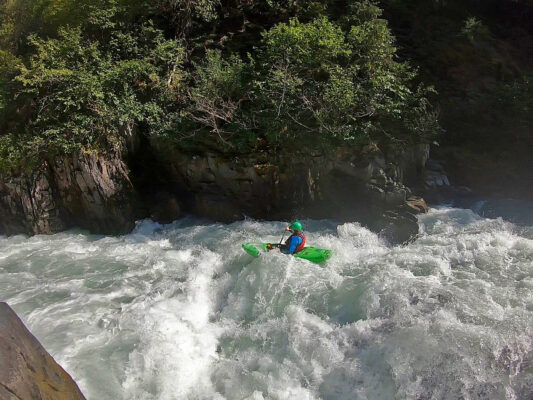 As I watched him accelerate down Merry Go Round’s entrance tongue, I grappled with the usual risk vs. reward debate. I had a pregnant wife at home, a dog, a desk job, and a mortgage. There were many people who cared about and relied on me. But it was only class IV+. Even if I were to crash, I would most likely wash up somewhere at the bottom. Images of the paddler I’d seen almost drown three years earlier not so far from this very spot, however, kept returning to my head. He likely hadn’t known the risk he was taking and it very nearly cost him everything. My mind also turned to a friend I lost while paddling in Ecuador and other people in my life who died before their time while braving one variety of risk or other. Gone was that naïve kid clumsily stabbing a canoe paddle into a lazy desert river: I’d learned that life was messy, tragic, and fragile. To live was to take risk, but was the reward I sought selfish or worth it? Was this “comeback” just a midlife crisis? Or was it somehow a noble, coming-into-wisdom moment my life desperately needed?
As I watched him accelerate down Merry Go Round’s entrance tongue, I grappled with the usual risk vs. reward debate. I had a pregnant wife at home, a dog, a desk job, and a mortgage. There were many people who cared about and relied on me. But it was only class IV+. Even if I were to crash, I would most likely wash up somewhere at the bottom. Images of the paddler I’d seen almost drown three years earlier not so far from this very spot, however, kept returning to my head. He likely hadn’t known the risk he was taking and it very nearly cost him everything. My mind also turned to a friend I lost while paddling in Ecuador and other people in my life who died before their time while braving one variety of risk or other. Gone was that naïve kid clumsily stabbing a canoe paddle into a lazy desert river: I’d learned that life was messy, tragic, and fragile. To live was to take risk, but was the reward I sought selfish or worth it? Was this “comeback” just a midlife crisis? Or was it somehow a noble, coming-into-wisdom moment my life desperately needed?
The truth was, I had no idea.
I knew from descriptions that Merry Go Round should be taken far left. Braden, however, entered almost dead center. Directly in front of me, he soared over a rounded hump and plummeted violently out of sight.
The result was violent and instantaneous.
His bow launched skyward in an acrobatic rear endo. He cartwheeled once, then twice. I struggled to watch while bracing through the heavy haystacks farther left. As I blew past, I caught a glimpse of him side-surfing what looked like a hole from hell. Eyes like dinner plates, he caught an edge, was sucked down into the maw, and vanished.
Rocking through the rapid’s tail waves, I spotted his head upstream of me bobbing in the frigid water beside his swamped kayak.
“Swim!” I shouted, nervously eyeing the next horizon line which announced a nasty plunge aptly named Jaws. Braden clawed into a river right eddy but his heavy boat floated on downstream. I tucked into a micro eddy at the lip of Jaws just in time to watch his green kayak bash down the torrent without a captain. A few moments later Braden arrived at my side looking waterlogged and disgruntled.
“I tried to save it,” I said. “But I wasn’t going to chase it through that.” We gawked at the growling chute below us.
“Looks like I’m walking,” he said and got to work thrashing down the rocky shore.
I was left alone with Sixmile. I pondered a portage but decided walking would only drive a compulsion to return. Instead, I settled on what looked like the easiest line and wedged my legs back into my kayak. In a way, it was perfect there would be no witness for this final test.
For all my scouting anxiety, Jaws passed in a blur of leaping haystacks and growling holes and I found myself at the bottom, wolf howling at the empty canyon walls.
Two corners later, I passed Braden fighting down the craggy shoreline. His kayak was nowhere in sight. I shouted that I would paddle ahead to search for it and got only a terse wave in response. I navigated the last of Sixmile’s rapids until the river dove into a deep pool and went silent.
My midlife crisis was complete.
At the takeout, a friendly kayaker had spotted Braden’s empty kayak and wrangled it to the opposite shore. I drained the boat, tied two throw bags together and yanked it across to the takeout beach. Only moments later, a shape appeared floating downstream. It was Braden.
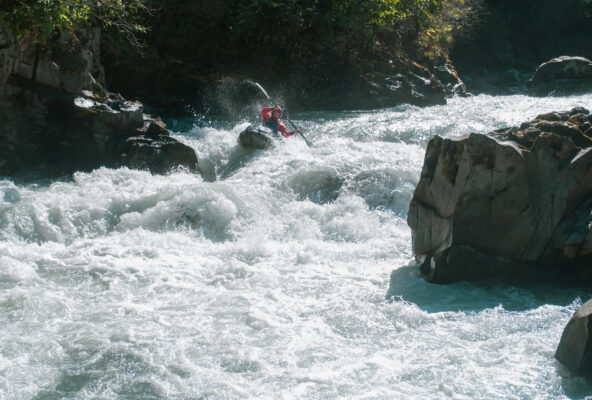
Photo by Braden Gunem
“Hey hey!” I cried. He kicked into the eddy and hauled out onto the sand like a sea lion.
“It was too rugged to hike,” he said. “So I swam.”
We laughed. We cracked beers. The sun was out, and there was not a trace of wind. Everyone and everything was accounted for. Sixmile rolled by, serene and placid below the rapids.’
I guess my comeback was a success. I was still approaching middle age. I was still facing the challenge of impending parenthood. My dog, my empty cubicle, my mortgage were all still waiting. These were important things: the joys and trials that make life what it is. But for one sunny July afternoon all my worries were set aside and I was immersed in the feeling of water rushing under my kayak and the scent of the river hanging in the crisp Alaskan air.
For one moment, it had been just me and my old friend, the river.
-Brian Wright
This article originally appeared in the September/October 2022 issue of American Whitewater Journal and is republished with permission.
Brian Wright is a photographer and writer residing in Alaska. He has degrees in creative writing and literature from Colorado Mesa University and has written for national publications such as Rock & Ice and the Mountain Gazette. When not tromping through the fantasy-like Alaskan backcountry, he is usually at home with his beautiful wife, amazing daughter, and shaggy mutt. This piece was previously published in American Whitewater Magazine.
Photos by Brian Wright, Claire Cripps, and Braden Gunem

